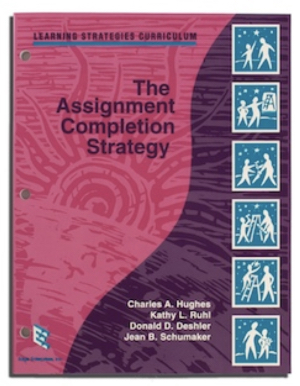The Assignment Completion Strategy

The Assignment Completion Strategy is designed to enable students to complete and hand in assignments on time. The package consists of two books: the Instructor's Manual, which provides step-by-step instruction for teaching this strategy, and the Quality Quest Planner, a spiral-bound notebook designed specifically for student use with the strategy. Each Instructor's Manual comes with one Quality Quest Planner and contains the materials needed to teach the strategy, including blank copies of the forms used with the planner. The planner contains sufficient forms for recording, scheduling, and evaluating assignments for an entire academic year.
Performance results in general education classes showed that the number of students who simply turned in their assignments before learning the Assignment Completion Strategy was 43 percent with the percentage increasing to 77 percent after students learned the strategy. Before learning the strategy, the number of student who did the assignment correctly was 45 percent. After learning the strategy, the number of students who did the assignment correctly increased to 73 percent. Research results have shown that after instruction, students turn in more of their homework assignments on time and get better grades on those assignments than they did on similar assignments before instruction. Most also receive better quarterly and semester grades.
Author(s):Charles A. Hughes, Kathy L. Ruhl, Donald D. Deshler, and Jean B. Schumaker
Publication Info: Edge Enterprises, 1995
Resources:
Research Articles:
- Hughes, C.A., Ruhl, K.L., Schumaker, J.B., & Deshler, D.D. (2002). Effects of instruction in an assignment completion strategy on the homework performance of students with learning disabilities in general education classes. Learning Disabilities Research & Practice, 17(1), 1-18. This article describes research results obtained when students used the Assignment Completion Strategy to plan for, complete, and turn in homework assignments on time. Eight of nine students mastered the strategy, their homework completion rates improved, and their quarterly grades increased.
The Story Behind the Assignment Completion Package from author Charlie Hughes:
Many students have difficulty with completing homework assignments, beginning with recording assignments accurately and completely, as well as developing a plan for how and when they will complete their assignments. My colleagues and I wanted to develop a strategy to help students complete these tasks as well as think about the quality of their homework products. As we worked on the strategy, we realized that we would need to develop a number of forms as part of this package. The forms eventually evolved to include a monthly planner to keep track of long-range assignments as well as other events or activities that would interact with their planning of schedules for completing the assignments. Additionally, since planning when to do homework is so critical, we included a weekly planner so that students could plan when they could and could not do homework. Finally, we included a form for recording and analyzing assignments. All these forms that are so critical to recording and planning homework have been compiled in an assignment notebook entitled The Quality Quest Planner.
I conducted the field-test for this strategy at a middle school where I worked while I took a sabbatical from Penn State (which reminded me what a tough job teaching really is!). The study was very successful, and all of the students began to complete more homework and earned better grades. However, I was struck by the fact that while they all did more homework (they doubled their production), they were still not completing all of their assignments. When asked why, the most frequent response was, “I did not know how to do it.” Clearly, this organizational strategy was helping them quite a bit, but their reports pointed out the fact that students often are asked to do things that they don’t know how to do!
Author's Thoughts about Strategic Instruction:
Based on my 25 years of work in the area of strategic instruction, I view this type of instruction as a key approach to the overall education of students with learning disabilities and other students who have difficulty learning. As a teacher, researcher, and parent, I have seen how much strategic instruction benefits students. Students not only learn these strategies and as a result perform better on school-related tasks, there is an overall benefit: they begin to see themselves as successful and competent learners. Another general benefit that I observe is that strategic instruction gives students a way of starting tasks and working their way through them. I often observed students just sitting at their desks looking at the assignment, test, or reading selection not knowing how or where to begin. Strategies are a concrete way of getting started and systematically solving problems and completing tasks. Not a small accomplishment!
This product is available through Edge Enterprises, Inc.
Please note that professional development, coaching, and infrastructure support are essential components to effective implementation of SIM instructional tools and interventions. It is highly recommended that you work with a SIM professional developer. See the SIM Event list for sessions or email simpd@ku.edu to learn more.
An accessible version of the documents on this site will be made available upon request. Please contact the KU CRL Professional Development Research Institute, at simpd@ku.edu to request the document be made available in an accessible format.